We’ve been exploring the best personality quiz prompt for ChatGPT. Josh, our CEO, has run this over a thousand times. It’s accurate around 50% of the time, which is great for a prompt. If it doesn’t work, you just rerun it, so it’s not a big deal!
Sure, AI can write personality quizzes, but our goal with this prompt is to produce an excellent one in our voice.
We’ve probably helped about a hundred customers build quizzes written in their voice using this prompt—and it’s a huge advantage. The best part about Josh’s prompt and setup is that it writes in your style and voice.
AI will initially make a quiz that sounds like ChatGPT wrote it, and that’s not what you want. You want AI to make your job easier when making a personality quiz, generating leads, and recommending your products. That’s exactly what Josh’s prompt does.
Let’s walk through the exact steps to fill in the prompt with your own information so that it speaks in your voice. Then, we’ll look at an output quiz. It might be a little intimidating initially, but we will break it all down for you.
You can jump into creating your prompt once you have your personality quiz idea. Depending on what you do, there’s a separate prompt for getting quiz ideas from your site or for your business. It’s easy to get started once you have an idea—that’s where we’ll begin with this prompt.
Let’s get started!
Table of contents
Writing In Your Own Voice
We first started with the below prompt:

The actual quiz title in the prompt is customized; the second half of the prompt is what you want the quiz to do. This is also where you could say, “I want to recommend my products, services, coaching programs, and courses.” Those are common recommendations people will make with these results from the quiz.
Now, let’s look at an example question:

The example question is where you can inject your own voice. You can do this by writing an example question, which will teach AI how you’d like it to write questions. Everybody asks questions differently, and that’s what will make your quiz unique.
You can also let AI create an example question for you. But again, it will be in the AI’s voice, not your voice. Your example question doesn’t necessarily have to be related to the quiz, but it will help.
Josh wrote the example question similar to how he talks. It shows how he would converse and answer this question if somebody were to ask him.
This is the first element of creating your personality quiz prompt. Let’s quickly review the first three steps:
- Create your quiz title.
- Tell AI what you want your quiz to do.
- Add an example quiz question (preferably in your own voice).
Now it’s time to look at the outcomes!
Creating Your Outcomes for the Best Personality Quiz Prompt for ChatGPT
This is where two paths diverge. You know exactly what you want your outcomes to be, and we’ve worked with several clients already in this space. Write your outcomes down in the following format:

Make sure to include your title in the first sentence. Then, add a description that includes what the outcome is, what type of person gets the outcome, why they got the outcome, and then specifics about what the outcome is.
There are two ways to do this:
- Write the outcomes as they are in the quiz. You can write verbatim what you want someone to see at the end of the quiz (see above image).
- Write a list of attributes about this type of person and the outcome (see below image).

Instead of explaining that resilience is the ability to bounce back, write bullet points describing the outcome. If you know what you want to tell people at the end—especially if you want specific courses, coaching programs, or products included in the outcome—write those descriptions yourself. Those descriptions, along with the outcome title, are somewhere between a hundred and a hundred and fifty words.
We highly recommend writing your own outcomes before you run this prompt. If you run it with a generic set of outcomes and realize you want to change it, you’ll have to start over again. If you know what you want, do it now. Our clients will get halfway through the process, and we’ll run a first version of this, and then they realize exactly what they want their outcomes to be.
You can still run it once to see what outcomes AI produces and then decide you don’t want to include an outcome. You can run the prompt multiple times, but it’s easier if you know what you want to show in your outcomes; do this before running it because it will save you time.
Writing your own outcome teaches AI, “This is how I talk, and this is how I write.” We realize that’s asking you to write part of a quiz, so again, you don’t have to do it. You can leave it blank, remove these elements from the prompt, or use our examples, which speak in Josh’s voice.
Josh has created several thousand quizzes, and his voice is on par with the best of what a quiz is. You can use his examples when you load the OpenAI Playground.
Side Note: We use the OpenAI Playground, but you can run this in ChatGPT. We just like the playground interface better.
Now that we have looked at the one written outcome, let’s take a closer look at all the outcomes.
There are ten outcomes because we want to include ten strengths in our “What’s Your Biggest Strength?” quiz.
Since we aren’t experts in telling people their biggest strength, we didn’t write this list of outcomes. We used Poe, and here’s a look at the output from there:
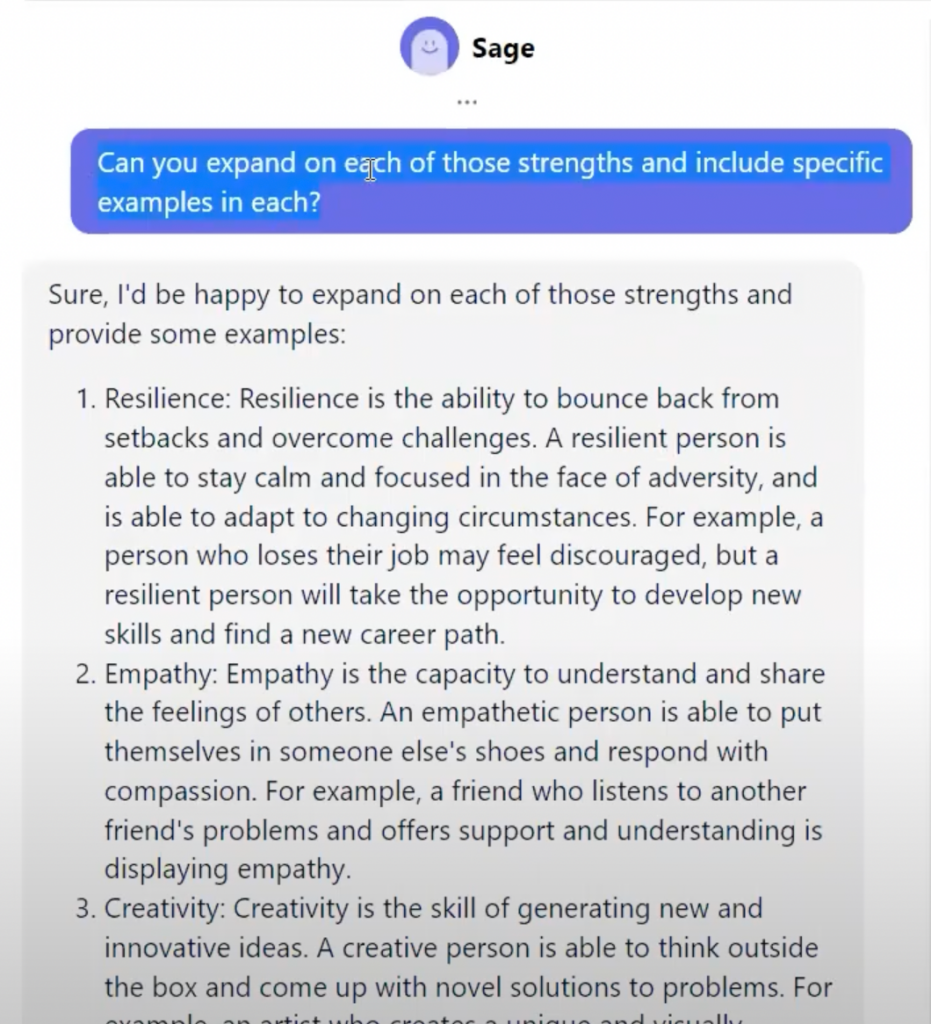
We used the Sage model in Poe but are continually testing. So far, Sage has worked the best for us. We’ll let you know if there’s ever a better model than Sage.
Poe has more data than OpenAI ChatGPT, and it gives much better outcomes if you’re starting from scratch. This tool is beneficial if you don’t know precisely what you want the outcomes to be.
You can see that all outcomes are in brackets, taken from HTML code.

This specific format helps separate the elements. The example outcome is within a bracket so the AI does not get confused. That’s the main goal with all the steps we are taking.
Let’s move on to the next steps!
This is the following prompt we used:

This also included the example quiz below:

We’ve spent so much time optimizing this prompt because it’s the best way to do it. The example quiz setup helps give the quiz a format that both the AI and the human understands.
Now, there’s one part you have to pay close attention to.

You can use “Command F” to find this section. It says, “Include seven questions with six answer choices per question.” That’s our recommendation for a thorough quiz with more than five outcomes. This gives enough questions to get enough data to make it accurate, and it puts it in a nice grid so you can use images in your answers.
Another common pairing is six questions and three answer choices, but you can use whatever pairing works best for you. We recommend that however many outcomes you have, you also have six times as many answer choices.
So if you have three outcomes, you want six questions or three answer choices. We don’t recommend going below five questions for a quiz because it doesn’t feel accurate. You want enough answer choices, so five questions with five answer choices per question would have 25 answer choices in total, which would work for a quiz with four or five outcomes. It could be a better science, but we can gauge what’s accurate enough in the next step.
Quiz Scoring
If you want to avoid going down the rabbit hole of scoring, you can use what we already have in the AI prompts we created for this. AI does scoring well because it knows exactly how to make the quiz accurate. It saves a ton of time because scoring is the most challenging part of creating this quiz.
To keep it short, you want every outcome to have an equal number of correlations. The way personality quiz scoring works is that every answer choice gives a point to one or more outcomes, and you want every outcome to have an equal number of points correlated. This is so there’s an equal chance of getting each outcome if you take the quiz.
The outcomes should pick up on how many outcomes you included in your prompt. If it doesn’t, then sometimes you’ll need to go here:

In this section, you can force the number of outcomes by including however many outcomes you want.
Let’s move on to submitting final prompts!
Submitting the Final Prompts for Best Personality Quiz Prompt for ChatGPT
Now it’s time to press “submit” and see what AI produces. It works great and is around 50% accurate. The first time we ran it, it messed up because it did not do the scoring correctly.
In this situation, you should rerun this because scoring is the most common thing to fail on. The second time we ran it, it worked perfectly.

The photo above is a tiny part of what the quiz that AI builds looks like after completing all the prompts, questions, and outcomes.
Your outcome should look similar to this:

AI gives you everything you need, including the opt-in form.
Using the Interact AI Quiz Builder
We already had this quiz in our Interact account, so we copied and pasted it over. If you want, we can also build the prompt for you or make the whole quiz for you.
We are building automations so that this all happens in the background. We’re waiting on some things, such as the availability of different APIs from places like Poe and different formats to come online. In the meantime, we are using human assistance, and the reality is there will always be human assistance with AI.
You can use this link to put your quiz on your website with any quiz ideas you have. We’ll walk you through this process as long as you are a paying member of Interact.
Here is what the quiz looks like in the quiz builder:
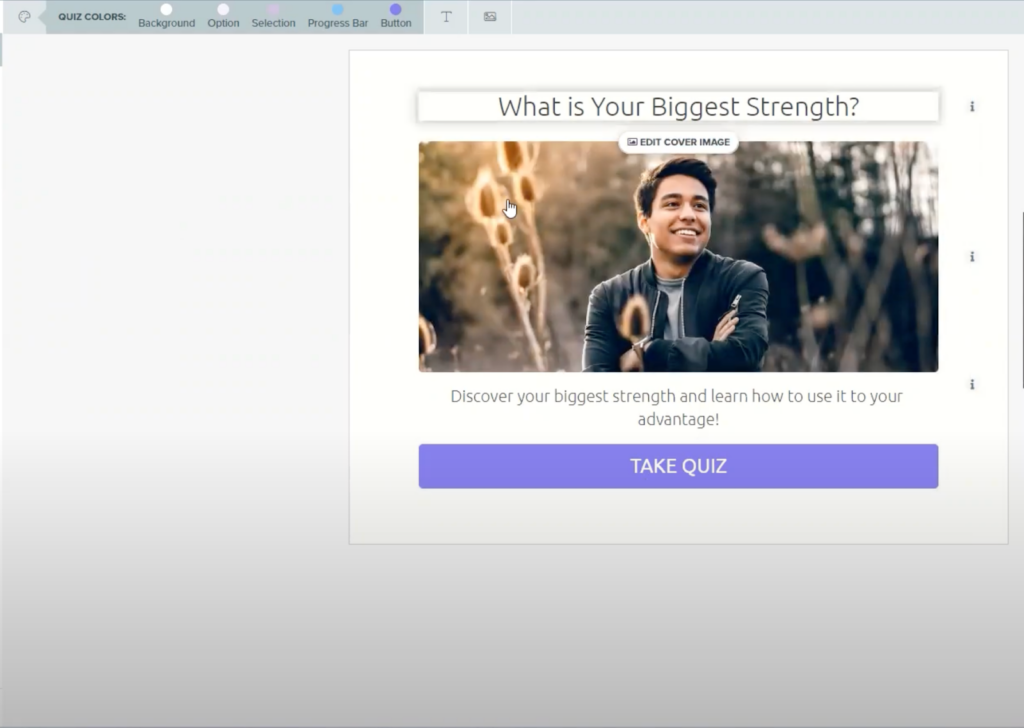
We put a color scheme on it and added images.
Here’s what the questions look like in the builder:
Here’s the result correlations that we were talking about from the quiz:
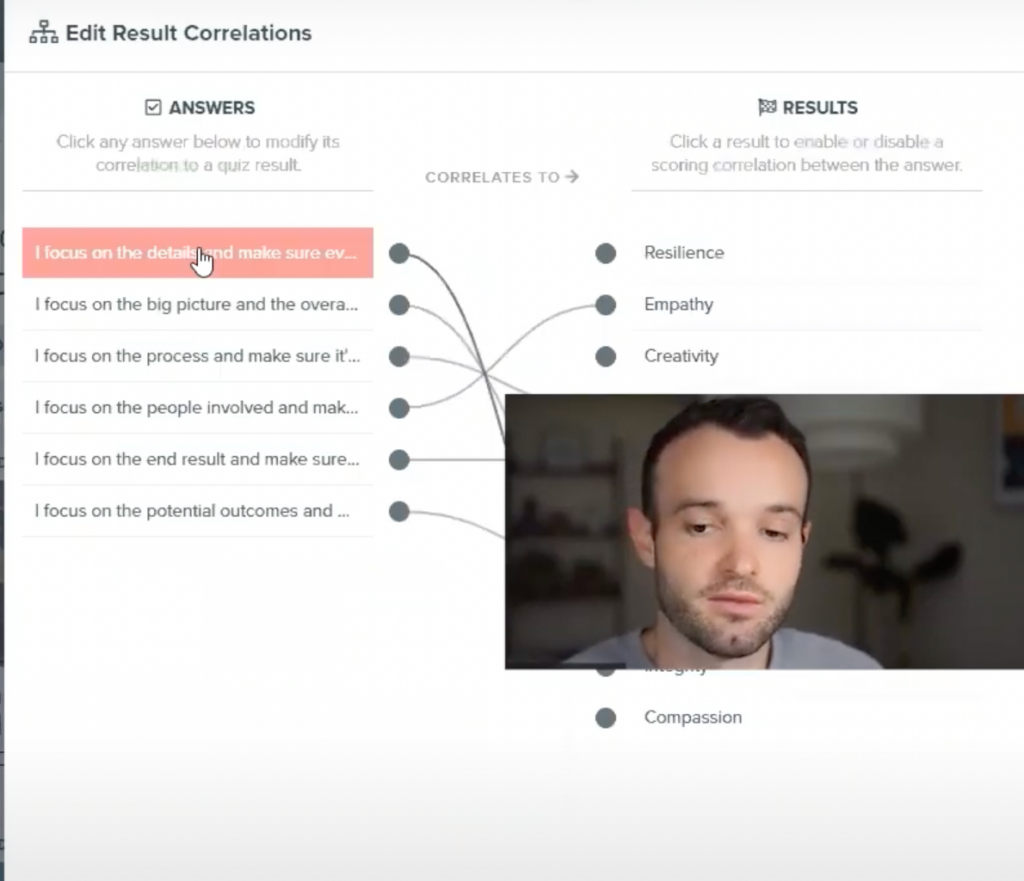
Here’s what the results look like:
We just quickly added images before publishing. We also shortened the quiz from seven questions to six questions.
Finally, you can easily turn on lead generation in the quiz builder:
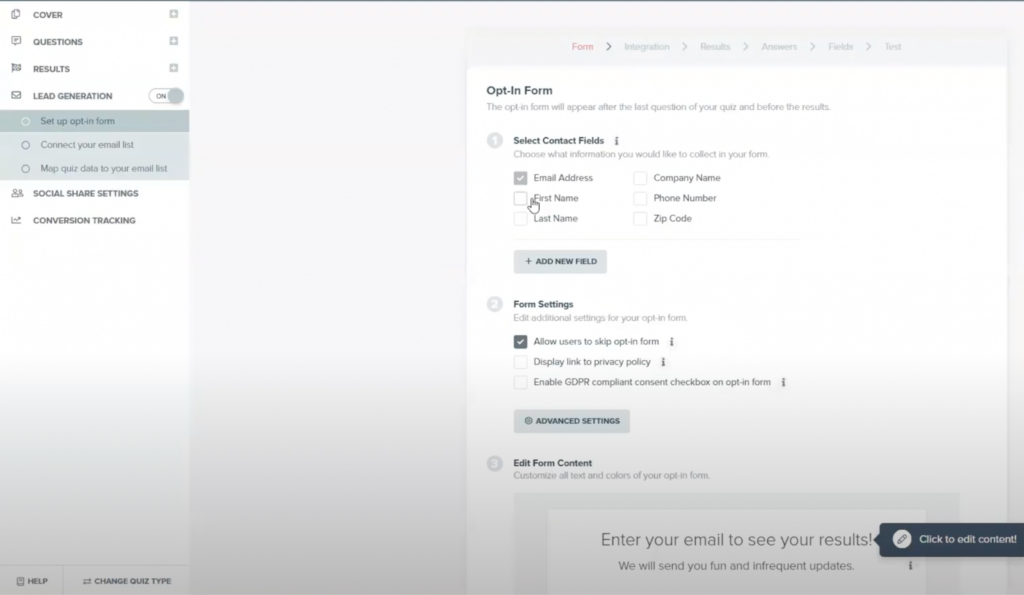
You can use the opt-in-form prompts from AI and copy and paste the opt-in-form headline and subheadline into the quiz builder.
We always recommend enabling GDPR compliant consent in the “Form Settings” section of your opt-in form.
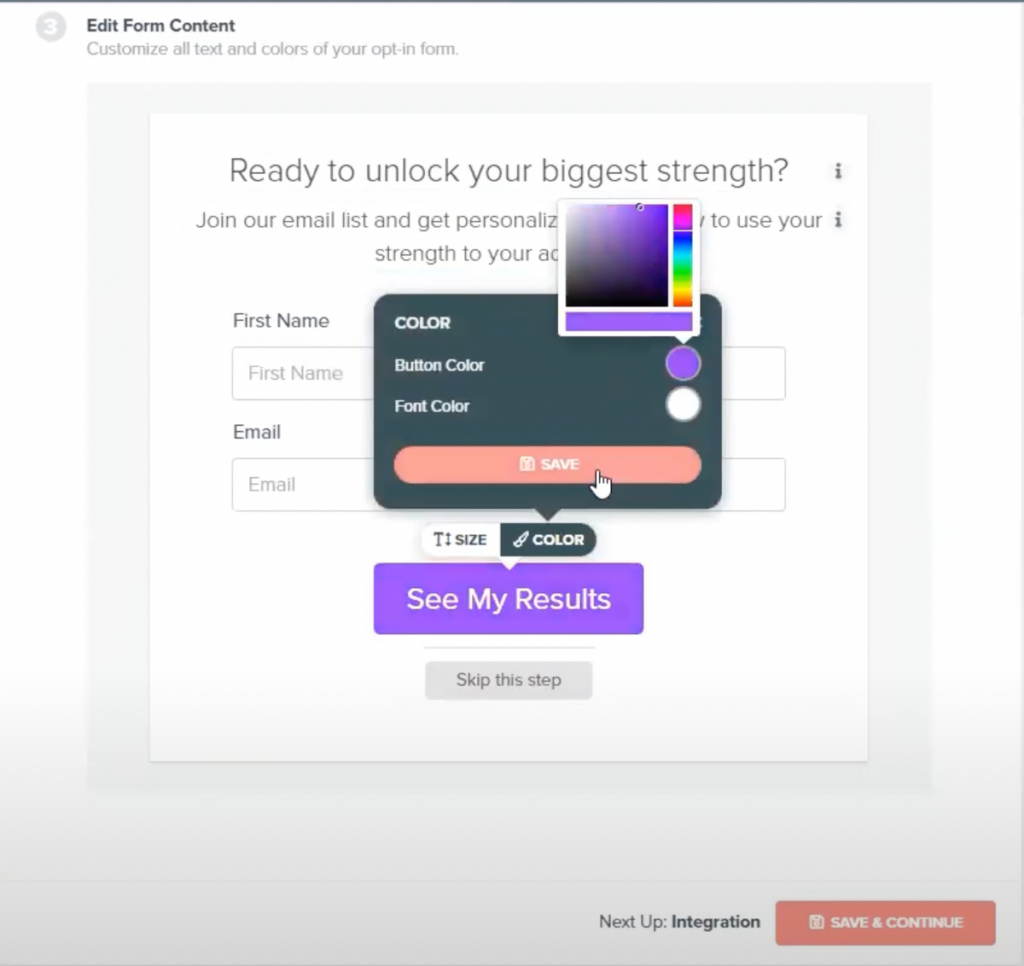
While editing the form, you can change the button color, as shown above.
Next, it’s time to connect integrations:
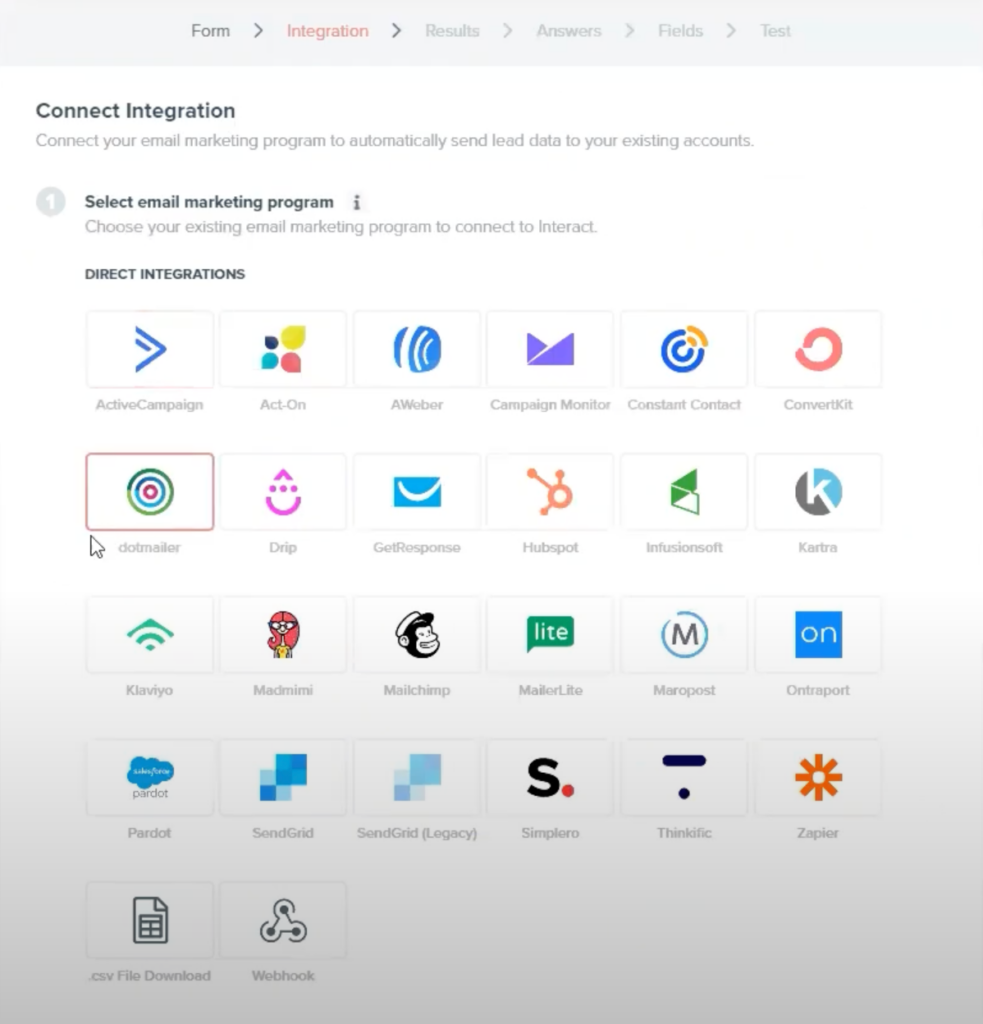
This will help you segment your leads. We have Hubspot connected, so we chose that platform to put people in different segment tags. Each outcome will go to a separate list that you can use.
Once you have finished finalizing your settings in the quiz builder, make sure you take your own quiz. If you don’t like taking the quiz, other people will probably not enjoy taking it, either.
Final Thoughts on the Best Personality Quiz Prompt for ChatGPT
This is the best prompt we have so far. To reiterate, Josh has used this about a thousand times for a hundred clients, and it has a high success rate. We have yet to have a client say they don’t like the output.
The quizzes that are coming out are excellent. You can use this exact prompt through the AI playground link to copy it into your playground and then change the elements.
Use our blog and video to go through which elements need to be changed to customize this. Make sure to customize the quiz so it writes in your own voice, and again, if you want us to do it for you, we are more than happy to help!
Editor’s note: This article was originally a transcript reworked by Sophia Stone, Interact Marketing Intern.